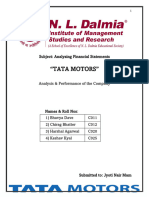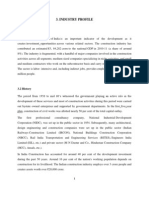Construction & Equipments Industry in India: June 2010
Construction & Equipments Industry in India: June 2010
Uploaded by
Vishal RastogiCopyright:
Available Formats
Construction & Equipments Industry in India: June 2010
Construction & Equipments Industry in India: June 2010
Uploaded by
Vishal RastogiOriginal Description:
Original Title
Copyright
Available Formats
Share this document
Did you find this document useful?
Is this content inappropriate?
Copyright:
Available Formats
Construction & Equipments Industry in India: June 2010
Construction & Equipments Industry in India: June 2010
Uploaded by
Vishal RastogiCopyright:
Available Formats
CONSTRUCTION & EQUIPMENTS
INDUSTRY IN INDIA
J une 2010
Report by the Indo-Italian Chamber of Commerce & Industry
Construction & Equipments Industry in India
Introduction
According to Construction World update, it has been projected that the present 1.6 billion
construction equipment industry in India is expected to touch about 10.3 billion. While the
current size is just a fraction of the world market, it has been growing between 10-15 %
compared to the global growth of around 5%.
The industry has been growing due to the large investments made by the Government [in the
form of external borrowings and internal accruals by Public-Private-Partnerships (PPP) model]
and the private sector infrastructure developments. The prospects of the construction
equipment industry look attractive with a projected investment of US$ 320 billion in the
infrastructure sector over 2007-2010. The Indian market is catered by about 200 domestic
manufacturers (small, medium & large). India is one among the top 10 markets for construction
equipment and is one of the key international markets. Indian firms are strengthening their
existing operations for catering to the growing domestic demand and are also planning to
expand to tap overseas markets. At the same time international majors have ambitious plans
for India considering that Indias per capita number of machines is very low at 13 machines per
million compared to 396 in America and 96 in China.
CONSTRUCTION INDUSTRY
As of 2009, the Indian construction industry, at current prices, contributed more than US$ 91
billion [ 62 billion] to the countrys gross domestic product (GDP). It employs more than 18
million people. Construction investments accounted for 11 % of GDP and 50 per cent of gross
fixed capital formation. Construction activity has grown at 11 % over the period 2006 to 2009.
Construction equipment accounts for 5 % - 24 % of construction project costs. Construction
equipment accounts for 22 % of road construction costs.
The Indo-Italian Chamber of Commerce & Industry December 2009 2
Construction & Equipments Industry in India
Investments & Capacity Expansion for Construction Industry in India
Investment in safe water supply and sanitation services is expected to touch 29 billion in
200910.
Urban transport infrastructure investments in cities with populations of 100,000 or more
during the next 20 years would be around 34 billion.
Investments in urban infrastructure have grown at a CAGR of 12.9 % over the period 2006
to 2009.
Investments worth 7 billion are expected in irrigation projects upto 2010.
Under the plan, 690 million was allocated for repair, renovation and restoration of 20,000
water bodies with a command area of 1.47 million hectares.
There is an increased emphasis on state government irrigational activities. For e.g. The
Andhra Pradesh government is expected to spend 6 billion on irrigation projects from
2009 to 2014.
60 % of irrigation investment goes into construction, of which 21 % is on construction
equipment.
Investment in Ports, airports and railways to drive construction equipment demand.
Cargo handled by ports in 2008 was expected to grow at 8 % in 2009.
Domestic and international inbound and outbound traffic is expected to increase over the
coming years.
The investment in developing airports is likely to be 6.2 billion upto 2011. The estimated
cost in upgrading airports in metros is around 1.51 billion.
Gas discoveries are likely to lead to an increase in pipeline networks, spurring demand for
construction equipment. An estimated 18,671 km. of a domestic oil and gas pipeline
network was expected to be laid over the period upto 2009.
India is to witness a huge boom in residential, commercial and retail construction. The
construction of 16 billion sq ft is expected by 2010. Real estate is likely to account for 61%
of total investment in the construction industry over the period 2008 to 2011.
The organised retail sector in India is expected to grow at a CAGR of 32 % over the next
10 years. Growth in organised retailing would drive organised logistics and warehousing
industries.
Steel majors are undertaking large capacity expansions. The steel industry has an
expected capex outlay of 10 billion to meet the needs of infrastructure projects, consumer
durables, automobile and construction industries over the Eleventh Plan period (2007
2012). Steel is expected to register 9 - 10 % growth over the period 2009 to 2014.
The power sector is expected to see investments worth 69 billion over the next 10 years
for capacity generation addition. Installed capacity is likely to increase to 212,000 MW by
2012 against 115,000 MW at present.
India has 355 opencast mechanised mines; 73 foreign direct investment (FDI) proposals
worth 570 million in the mining sector are still to be approved. Coal mining accounts for
The Indo-Italian Chamber of Commerce & Industry December 2009 3
Construction & Equipments Industry in India
80 % of mining activity in India. The expected growth in coal mining is 40 % in the next five
years and almost double by 2020.
Challenges & Opportunities in the construction sector
The major challenge that the construction industry faces during the next five years, is to raise
its delivery capabilities commensurate with the 11
th
Commission Plan [2007-2012] targets for
sectors such as transportation, housing, and urban development. The planned development of
infrastructure would face constraints, unless the construction industry improves the delivery
potentials by addressing crucial issues and impediments by bringing in systemic changes.
Productivity
R&D in the construction industry should be seen as a continuing activity, because the
scientific and technological advancements are needed to strengthen and raise the
technological base of the construction industry. Support to the national institutions engaged
in scientific research and incentives for private sector players to undertake in-house R&D
need to be provided.
Introduction of efficient technologies and modern management techniques to raise the
productivity of the industry are vital.
Introduction of new technologies, construction systems, and energy-efficient materials
(preferably based on waste recycling) needs to be adequately emphasized in the
national strategy
For R&D sector, there is a need for developing and introducing use of marginal materials
to enhance the cost effectiveness of works. Adequate funds should be earmarked in the
field of R&D for identification of appropriate and alternate materials to reduce the cost of
construction.
Management of information in contemporary construction projects is one of the biggest
challenges that project teams face in the upgradation of productivity levels. Information
technology can be leveraged to address issues related to tendering, bidding, bid
evaluation, grading of construction entities, project execution logistics, project
management, as well as financial accounting and reporting for the construction industry.
Human Resource and Entrepreneurial Development Framework
The major impediments faced by the construction industry in raising the levels of productivity
are the acute shortage of skilled manpower, both at worker and supervisory levels, as well as
the lack of experienced construction engineers. The construction industry, particularly the
highway and road construction sectors, is facing acute shortages of contracting agencies. The
present situation is marked by lack of a harmonized skill upgradation and certification
programme for construction workers and lack of incentives and regulatory framework to
prescribe a certain percentage of trained and certified manpower by the contractors.
The Indo-Italian Chamber of Commerce & Industry December 2009 4
Construction & Equipments Industry in India
There is also a need to encourage adequate intake of civil engineers in engineering institutions
to mitigate the existing shortage. A National Plan for training and certification of construction
personnel at all levels needs to be developed and implemented.
CIDCO (Construction Industry development Council), in association with several
universities and industry constituents, has offered an HRD (Human Resource
Development) Programme for the workers from construction industry for last three
years. The programme, based on an open learning and distant mode of education,
offers 38 trades through 19 centres situated in various parts of the country.
Need to reduce Construction Cost
Efforts are required to streamline procedures and mechanisms within the industry as
well as enhance the levels of quality for the sector as a whole.
It is estimated that the total cost of procuring, monitoring, and supervising and other
indirect costs of construction projects consists of about 22% of the cost of the asset
that is created.
Quality and Standards
To make the Indian construction industry more competitive, aspects related to enhanced
quality in construction products should be accorded attention at all levels. The inadequate
quality in construction works emanates from lack of incentives for inducting new technology,
lack of pre-qualification requirements for trained and certified workmen, lack of appreciation for
lifecycle costing approach, and lack of adequate R&D. In order to enhance the technological
capabilities of the industry, all stakeholders would be required to actively support training and
certification levels for skilled workers, supervisors, and managers, and promote construction
techniques (such as ready-mixed concrete, pre-fab techniques) that use information
technology.
Safety and Related Issues of Construction Workers
Workers employed in construction activity are highly vulnerable segments of the labour force
particularly because of its unorganized nature. The workers in construction industry are
vulnerable to the inherent risk to their life and limbs. Construction activities are also
characterized by poor training, temporary relationships between the employer and the
employee, uncertain working hours, lack of basic amenities, inadequacy of welfare facilities,
and casual approach of employers towards the problems of employees.
Others
Enhance capacity building in the construction sector by improving productivity through
introduction of efficient technologies and modern management techniques.
Develop a National Plan for human resource development through training and
certification of construction personnel.
The Indo-Italian Chamber of Commerce & Industry December 2009 5
Construction & Equipments Industry in India
Accord greater importance to safety in construction activities by establishing trained and
certified Safety Management Teams.
Earmark funds in the field of R&D for identification of appropriate and alternate materials to
reduce the cost of construction.
Reduce transactional costs by reviewing contract procedures and dispute resolution
mechanisms.
Enhance quality standards and provision of adequate institutional finance to the
construction sector.
EQUIPMENT SECTOR
Product consumption constitutes the bulk of the segment with around 56 per cent while the
unorganized sector contributes to around 15 per cent. Unorganised players are more prevalent
in the relatively less technology intensive material handling, material preparation and concrete
equipment segments. The imports market is estimated around 400 - 450 million. Of these,
the earthmoving, excavation and hauling equipment categories command around 25 per cent.
Imported used equipments, which include high-end hydraulic mobile cranes, excavators, motor
graders, vibratory compactors comprise a negligible 0.4 per cent of the total construction
equipment market. The potential exports market for construction equipment from India is
projected to be around 75 million by 2010. Spare parts revenues range anywhere from 20
29 per cent of the total sales for representative companies and are predominant in tunneling
and drilling equipments. Services revenues have been higher for global players at around 11
20 per cent in comparison to 28 per cent of Indian players.
Construction & Material Handling Equipment
Industry
Products 56%
Spare Parts 21%
Unorganised Sector 15%
Services 6%
Exports 2%
Segmentation
The key segments that constitute the Construction Equipment industry in India are
1. Earth Moving Equipment
2. Concrete Equipment
3. Material Handling Equipment
4. Road Construction Equipment
5. Construction Vehicles
6. Tunnelling & Drilling
The Indo-Italian Chamber of Commerce & Industry December 2009 6
Construction & Equipments Industry in India
There are several ranges of products in each segment:
Source: IBEF
However, only a few segments dominate this industry: Earthmoving Equipments constitute the
biggest segment in this sector.
.
Construction Equipment Industry Structure
Earth Moving Equipment 57%
Material Handling 13%
Tunnelling & Drilling for Mining 12%
Road Construction Equipment 7%
Concrete Equipment 6%
Concrete Preparations 5%
Source: KPMG Analysis, Primary Research; CII-KPMG Report on Indian Infrastructure
The Indo-Italian Chamber of Commerce & Industry December 2009 7
Construction & Equipments Industry in India
Earthmoving Equipments
Amongst the Earth moving equipment sector Excavators is the largest product line within the
segment. The following is the forecast for the Earthmoving Equipment Segment:
Excavators
The excavator market in India was around 750-800 million in FY09. In excavators [8 tonnes
to 80 tonnes size] the 2009 market was around 7500 units according to industry estimates. The
market for 2010 is expected to increase by 20% to around 9000 units. [But, according to Off-
Highway Research, there were 7944 excavators sold in India last year, making it the fourth
largest market in the world for these machines after China, the US and J apan. However, the
economic research company forecasts the Indian excavator market to almost triple over the
next five years, with 22500 machines expected to be sold in 2014. This would see it overtake
J apan and possibly the US as well]
The 20-tonne excavators have a 50% market share selling around 4000 units annually in this
segment. Thus far, while Excavators have registered a CAGR of 36 %, before slowdown
recession hit high-end excavators are in more demand than lower-end excavators. The lower-
end demand is from irrigation projects. The higher-end demand is from the mining and cement
industries. New technology, end-to-end solutions are also important.
Types of Excavators:
1- Compact excavator (Mini Excavator)
2- Dragline excavator
3- Bucket-wheel excavator
4- Long-reach excavator
5- Long front excavator
6- Hydraulic excavator (Hydro excavator)
The Indo-Italian Chamber of Commerce & Industry December 2009 8
Construction & Equipments Industry in India
The market leaders are L & T Komatsu, a joint-venture (J V) between Larsen & Toubro and
Komatsu, and Telcon, a Hitachi-Tata Motors J V, which each claim about a 40% market share.
Other major players are Volvo, Hyundai Constructions Equipment India, Kobelco Construction
Machinery Co.; Doosan Infractore Co., CAT and J CB.
Volvo Construction Equipment is investing INR 900 million to produce medium sized
excavators customized for the Indian market keeping in mind the diverse requirements of the
burgeoning construction and infrastructure sectors. J apanese earthmoving equipment company
Kobelco Construction Machinery invested around 6.8 million to set up a hydraulic excavator
factory in Andhra Pradhesh. While they will manufacture 1200 units of 20-tonne excavators
annually, they continue to import other capacities like 14-tonne, 35-tonne and 50-tonne
excavators. J CB is also building a new 35 million factory in Pune for the manufacture of
excavators to initially manufacture 20 tonne-class J S 200 tracked excavators. J CB sold 600
units in this segment last year. This new facility will have the capacity to produce 5000-6000
units annually.
Backhoe
India is the second largest market for backhoe loaders in the world with a market size of
approximately 400 million. Going ahead growth is likely to be at least 11 % CAGR over the
next few years. The market for backhoes is spreading eastwards, largely due to the way in
which India is industrializing. J CB India is the leader in this segment with a share of over 70 %.
Other players include Telcon, L&T, Caterpillar and Terex.
While technology plays a key role especially for lowering operating costs by making the
machine more fuel efficient, it is not perceived to be as important for backhoes as it is for
excavators. With more players and increased competition, price competition may increase. The
drivers for this market have been the housing and urban construction. Backhoes are used for
all construction applications and hence have a very high utilisation for renters. Backhoes are
perhaps the only market in India amongst construction equipment that have reached a stage of
maturity and scale where exports could be considered.
J CBs 40 million backhoe loader factory in India in Ballabgarh, Faridabad, the largest plant
of its kind anywhere in the world enables J CB to produce 100 backhoes a day in India. The
J CB backhoe remains the first in its field the number one backhoe loader in India, from
Indias number one manufacturer of construction equipment - the number one in the world, with
every one in three sold anywhere in the world today coming from a J CB factory. Ashok Leyland
J ohn Deere Construction Equipment Private Ltd newly formed J V will commence production
from October 2010 and serial production by J anuary 2011 near Chennai. The J V will initially
manufacture backhoes and wheel loaders and will market backhoes, wheel loaders and
excavators in India and abroad. The range will subsequently be expanded to include a full line
of construction equipment.
The Indo-Italian Chamber of Commerce & Industry December 2009 9
Construction & Equipments Industry in India
Loaders
Loaders are used mainly for uploading materials into trucks, laying pipes, clearing rubble, and
digging. The flexibility of usage is low as compared to a backhoe and loaders are largely used
as complimentary products for material re-handling in construction and mining applications.
Iron ore mining activities create the major demand for loaders in the country. The total market
for wheeled loaders was approximately 80 million in 2009 with around 4000 units being sold.
The growth is expected to continue at 10 % CAGR over the next few years. As in the case of
backhoes, faster growth of about 20-30 per cent is expected in the near term. Unlike
excavators, the growth in loaders is greater in the lower capacity categories (<10T): 1.5-8 Ton
range have a sizeable presence and demand in India.
Wheeled loaders in the medium 100 to 150 horsepower class, fitted with a 1.7-2.5 m3 bucket
are renowned for their high productivity, reliability and ease of servicing as they are ideally
matched with locally-made tipper trucks used to carry loose materials both on and between job
sites.
Key players in the Loaders market are Caterpillar (~50 per cent share), J CB and Telcon with
L&T Komatsu, Ingersoll Rand and Volvo being players with a relatively smaller presence. In the
high capacity loaders market (>15T), Volvo is a significant player. Most of the customers for
loaders are first time buyers and this is the reason for huge sales of lower end loaders. J ust as
it is for excavators, a complete range of products and comprehensive maintenance and service
support are becoming the critical success factors for players in the industry. The demand of
loaders is from increased global demand for iron ore mining activities in the country.
LiuGong India Private Limited, a subsidiary of Guangxi Liu Gong Machinery Company (China),
has inaugurated its new manufacturing facility for heavy earth moving machines & construction
equipment at Pithampur, Madhya Pradesh at an investment of 24 million. New factory will
begin by manufacturing wheel loaders and gradually will assemble/manufacture the full range
of LiuGong products in India, which include Crawled Excavator, Backhoe Loader, Road
Equipment etc. Anupam Industries Limited (ANUPAM), India's largest overhead crane builder,
has signed a licensing agreement with Mitsubishi Heavy Industries, Ltd. (MHI) of J apan. MHI
will provide Anupam with technology licensing for quayside cranes such as container cranes
and transfer cranes, material handling systems such as loaders and unloaders, and steel
plant logistics systems. Under the agreement, initially the licensed products will be sold in
India's domestic market only.
The Indo-Italian Chamber of Commerce & Industry December 2009 10
Construction & Equipments Industry in India
Growth Drivers
The prime driver for construction equipment is mining activities and construction industry.
Within these industries, the key demand drivers going forward are likely to be road
construction, urban infrastructure, irrigation, real estate, construction and mining.
Others
Contractors are also on the look-out for good quality and efficient working equipment as time is
of essence in the present day construction situations. For e.g. For Road Construction,
excavators, wheel loaders, motor graders, soil compactors, asphalt pavers, pneumatic rollers,
bitumen distributors and road marking is in demand. This is so as the Ministry of Surface
Transport, Government of India has set up a target of constructing 20 km of new roads per day.
In addition, rural roads have also to be developed. Also, the National Highway Authority of India
NHAI officials are now very strict regarding the quality of new roads being awarded and have
very clearly specified in the contracts the type of equipment that must be used by the civil
contractors. The contractors have also realized that to complete the construction of the roads in
time, they have to use above mentioned equipment for completion as well as maintaining the
quality of the roads as per NHAI standards.
Another driver apart from construction of new roads is the maintenance of existing roads and
enhancing their construction life. State governments in India are incurring huge amounts on
repair of roads after each monsoons and it is done in a haphazard manner using obsolete
equipments. Civic bodies like Public Works Departments PWDs and municipal committees are
now realizing that need to properly maintain the roads.
The Indo-Italian Chamber of Commerce & Industry December 2009 11
Construction & Equipments Industry in India
Service Gaps
According to Mr. KV Rangaswami, Whole Time Director & President [Construction], Larsen &
Tubro [L&T], the industry is not at all sufficient in all categories of machineries essential for the
industry, although for that matter, even the very big companies in the industry are yet to acquire
many strategic machineries with latest technology. In order to meet international benchmark
levels of quality, speed and safety, Indian construction companies need to upgrade themselves
in many spheres of execution. This process must happen continuously as the gap is very large
from the point of view of international standards and the vast scope of projects in infrastructure
building and construction of residential, commercial and industrial complexes needed to be
fulfilled in the next 5- 7 years.
At any given time the construction industry faces a short supply of a certain classes of
specialized equipment, such as pneumatic tire rollers for road applications, pavers, soil
stabilization and foundation equipment like vibratory hammers and diaphragm walling kits and
attachments used to lay foundations.
The Indo-Italian Chamber of Commerce & Industry December 2009 12
You might also like
- (Ebooks PDF) Download Istio in Action 1st Edition Christian E. Posta Full ChaptersDocument49 pages(Ebooks PDF) Download Istio in Action 1st Edition Christian E. Posta Full ChaptershovdasombirNo ratings yet
- Excavation Method Statement PDFDocument10 pagesExcavation Method Statement PDFMohammad Bader Al-Dein100% (14)
- ANALYSIS-79-Light & Medium Duty State Wise Truck Market Analysis With Kerala Case Study - ACG PDFDocument29 pagesANALYSIS-79-Light & Medium Duty State Wise Truck Market Analysis With Kerala Case Study - ACG PDFVivek SinghalNo ratings yet
- Force Motors - Strategy PresentationDocument14 pagesForce Motors - Strategy PresentationRahul Yadav67% (3)
- Economic Analysis of Indian Construction IndustryDocument23 pagesEconomic Analysis of Indian Construction Industryaishuroc100% (2)
- BCO Office GuideDocument24 pagesBCO Office GuideChris PatienceNo ratings yet
- Tennyson's The Brook - Analysis and SummaryDocument9 pagesTennyson's The Brook - Analysis and Summarypurplerain734100% (8)
- Material Handling India PDFDocument7 pagesMaterial Handling India PDFsangeeth_7No ratings yet
- Construction Equipment 060710Document23 pagesConstruction Equipment 060710Uday NarayanNo ratings yet
- Construction IndustryDocument7 pagesConstruction IndustryVishal RastogiNo ratings yet
- Operations and Supply Management Individual ReportDocument10 pagesOperations and Supply Management Individual ReportKartik RajpurohitNo ratings yet
- India Market Size, Industry Vertical and Analysis by 2022Document5 pagesIndia Market Size, Industry Vertical and Analysis by 2022avisekNo ratings yet
- Indian Construction Equipment IndustryDocument4 pagesIndian Construction Equipment Industryvenkat_MandaliNo ratings yet
- An Internship Report On Organizational Study atDocument88 pagesAn Internship Report On Organizational Study atNesica EstherNo ratings yet
- Tata, TipperDocument95 pagesTata, Tippermonika_richaNo ratings yet
- Oswal Pumps: The Legacy of Technology PerfectionDocument11 pagesOswal Pumps: The Legacy of Technology PerfectionKalyan ChNo ratings yet
- Global Manufacturing ReportDocument11 pagesGlobal Manufacturing ReportwinnieXDNo ratings yet
- Ashok LeylandDocument59 pagesAshok LeylandManjeet Singh100% (1)
- JCB PresentationDocument15 pagesJCB PresentationMitanshu Bansal40% (5)
- Indian Washing Machine IndustryDocument6 pagesIndian Washing Machine IndustryManish ChhariNo ratings yet
- Steel Indonesia ListDocument1 pageSteel Indonesia ListJabi SihalohoNo ratings yet
- Domestic-Fan-Industry ProjectDocument21 pagesDomestic-Fan-Industry ProjectRajib RhdNo ratings yet
- Automobile Industry - Marketing MixDocument35 pagesAutomobile Industry - Marketing MixmupadeNo ratings yet
- Automotive Tyre Manufacturers' Association (ATMA)Document21 pagesAutomotive Tyre Manufacturers' Association (ATMA)flower87No ratings yet
- Logistics Industry - IndiaDocument16 pagesLogistics Industry - Indiasandy4213No ratings yet
- India Construction Machinery Industry Outlook 2016Document60 pagesIndia Construction Machinery Industry Outlook 2016SaurabhBhasinNo ratings yet
- The Best of India in Engineering 2017Document166 pagesThe Best of India in Engineering 2017Navdurga RetailNo ratings yet
- Ola Electric-1Document10 pagesOla Electric-1ANJALA S SNo ratings yet
- Project Report On Automobile Sector: Submitted By: - SHARDUL BHARDWAJ (PG20112209)Document9 pagesProject Report On Automobile Sector: Submitted By: - SHARDUL BHARDWAJ (PG20112209)Yash BansalNo ratings yet
- Construction Equipment: September 2009Document34 pagesConstruction Equipment: September 2009Dhruv DaveNo ratings yet
- IRB Infrastructure Developers LTDDocument18 pagesIRB Infrastructure Developers LTDSwati SinhaNo ratings yet
- India Construction Equipment Leasing ReportDocument31 pagesIndia Construction Equipment Leasing Reportjinalshah1012713No ratings yet
- DMIC BriefDocument5 pagesDMIC Brieflocus1No ratings yet
- Automobile IndustryDocument4 pagesAutomobile IndustryDarshnaNo ratings yet
- Industry ProfileDocument20 pagesIndustry ProfileShanu shriNo ratings yet
- Project Report MainDocument63 pagesProject Report MainJominson_Ambal_3968No ratings yet
- Marketing Strategies of KIA MotorsDocument5 pagesMarketing Strategies of KIA MotorsInternational Journal of Innovative Science and Research TechnologyNo ratings yet
- MG Motor India - WikipediaDocument9 pagesMG Motor India - WikipediaNUTHI SIVA SANTHANNo ratings yet
- Automotive Industry in IndiaDocument35 pagesAutomotive Industry in IndiasreedhanyNo ratings yet
- Gateway To Opportunities: MR - Akira Amari & Delegates From JapanDocument17 pagesGateway To Opportunities: MR - Akira Amari & Delegates From Japankrishna_edNo ratings yet
- Final PPT of MahindraDocument17 pagesFinal PPT of MahindraTopesh SharmaNo ratings yet
- Exide Industries Equity Research ReportDocument9 pagesExide Industries Equity Research ReportAadith RamanNo ratings yet
- 34 Tvs Apache in ShimogaDocument102 pages34 Tvs Apache in Shimogaavinash_s1302No ratings yet
- Automobile Sector-Two Wheeler SegmentDocument41 pagesAutomobile Sector-Two Wheeler SegmentSandhya UpadhyayNo ratings yet
- Automobile IndustryDocument15 pagesAutomobile Industryanoop_mishra1986No ratings yet
- Make in India WeekDocument23 pagesMake in India WeekGanesh EshwarNo ratings yet
- KAMDHENUDocument31 pagesKAMDHENUAman Bakhshi0% (1)
- Samyak Agarwal (M-703) - Vaibhav Agarwal (M-704)Document31 pagesSamyak Agarwal (M-703) - Vaibhav Agarwal (M-704)Vaibhav AgarwalNo ratings yet
- Indian Automotive Industry Report 250608Document28 pagesIndian Automotive Industry Report 250608workosaur100% (6)
- Executed Project ListDocument2 pagesExecuted Project ListVasim ShaikhNo ratings yet
- Company Name Type. Year Established Head Quarter Company Size Key People Business TypeDocument37 pagesCompany Name Type. Year Established Head Quarter Company Size Key People Business TypeShakti AnandNo ratings yet
- Maruti Suzuki India Ltd. (MSIL) : History and LegacyDocument27 pagesMaruti Suzuki India Ltd. (MSIL) : History and Legacykuldeep singhNo ratings yet
- Sanjeev Auto Parts Inplant Project ...Document36 pagesSanjeev Auto Parts Inplant Project ...Sagar Shinde100% (2)
- Automobiles Industry in IndiaDocument79 pagesAutomobiles Industry in India2014rajpoint0% (1)
- Construction Equipment September 2016 PDFDocument43 pagesConstruction Equipment September 2016 PDFSandeep KumarNo ratings yet
- Tata Motors - 4 - C - ReportDocument38 pagesTata Motors - 4 - C - ReportHarshal AgarwalNo ratings yet
- Automobiles ManufacturingDocument16 pagesAutomobiles ManufacturingAnirudh Singh100% (1)
- Construction: Project ManagementDocument61 pagesConstruction: Project ManagementAbbas AliNo ratings yet
- Group 3 Economics SubmissionDocument11 pagesGroup 3 Economics SubmissionSHIVANSHUNo ratings yet
- L&T Pest Analysis-Back UpDocument15 pagesL&T Pest Analysis-Back UpAnkit Godre50% (2)
- Current State and Factors Inhibiting GrowthDocument20 pagesCurrent State and Factors Inhibiting GrowthKirti ChotwaniNo ratings yet
- Outlook For Indian Construction Industry Till 2020Document7 pagesOutlook For Indian Construction Industry Till 2020Priyashri MishraNo ratings yet
- Indian Construction IndustryDocument3 pagesIndian Construction IndustryfiiimpactNo ratings yet
- Construction IndustryDocument7 pagesConstruction IndustryVaishnavi KrushakthiNo ratings yet
- Fuel Cells & Electrolyzers Supply Chain Report - FinalDocument91 pagesFuel Cells & Electrolyzers Supply Chain Report - FinalVishal RastogiNo ratings yet
- MOP Annual Report Eng 2021-22Document240 pagesMOP Annual Report Eng 2021-22Vishal RastogiNo ratings yet
- KEPCO's First 5000 MW of Flue Gas Desulfurization: Babcock & Wilcox Barberton, Ohio, U.S.ADocument6 pagesKEPCO's First 5000 MW of Flue Gas Desulfurization: Babcock & Wilcox Barberton, Ohio, U.S.AVishal RastogiNo ratings yet
- Clutches: Declassified: Engineers Want Reliability, Consistency and CustomizationDocument4 pagesClutches: Declassified: Engineers Want Reliability, Consistency and CustomizationVishal RastogiNo ratings yet
- Module 5: Force Method - Introduction and Applications Lecture 1: Analysis of Statically Indeterminate BeamsDocument11 pagesModule 5: Force Method - Introduction and Applications Lecture 1: Analysis of Statically Indeterminate BeamsVishal RastogiNo ratings yet
- Note Printing CostDocument3 pagesNote Printing CostVishal RastogiNo ratings yet
- Strategic Computing and Communications Technolgy: - Course Web Page - RequirementsDocument24 pagesStrategic Computing and Communications Technolgy: - Course Web Page - RequirementsVishal RastogiNo ratings yet
- Sugar 2011Document102 pagesSugar 2011Vishal Rastogi100% (1)
- Bip Vadodara 100812.doc FreshDocument43 pagesBip Vadodara 100812.doc FreshVishal RastogiNo ratings yet
- New Technologies Beg The Question-Were We Hasty in Dumping The Edison Light Bulb?Document4 pagesNew Technologies Beg The Question-Were We Hasty in Dumping The Edison Light Bulb?Vishal RastogiNo ratings yet
- Wholesale Cancellation of Coal Blocks Is Beginning of Country's End: Deepak Parekh, Chairman, HDFCDocument3 pagesWholesale Cancellation of Coal Blocks Is Beginning of Country's End: Deepak Parekh, Chairman, HDFCVishal RastogiNo ratings yet
- Power of DoublingDocument8 pagesPower of DoublingShubham KumarNo ratings yet
- Cadre Scheme For Non Executives From Ncwa-I To Ncwa-IV 13072015Document261 pagesCadre Scheme For Non Executives From Ncwa-I To Ncwa-IV 13072015vengala krishna prasad91% (11)
- Gempur Kecemerlangan SPM 2023: Bahasa Inggeris Kertas 1 (Reading) 1 Jam 30 MinitDocument13 pagesGempur Kecemerlangan SPM 2023: Bahasa Inggeris Kertas 1 (Reading) 1 Jam 30 Minitjane gréyNo ratings yet
- Class 9 NotesDocument7 pagesClass 9 Notesjesi2210No ratings yet
- Brkarc 2003Document31 pagesBrkarc 2003Praveen RaiNo ratings yet
- ISO9141-2 On OBDIIDocument115 pagesISO9141-2 On OBDIILojze MiškovičNo ratings yet
- Segmentation Using Morphological Watershed TransformationDocument12 pagesSegmentation Using Morphological Watershed Transformationdevineni amulyaNo ratings yet
- Calibre 16Document10 pagesCalibre 16Pablo BurchardNo ratings yet
- Mobile Based IVR SystemDocument17 pagesMobile Based IVR SystemIndraysh Vijay [EC - 76]No ratings yet
- 2 DLP in Esp Expanded Definition of Words 2Document12 pages2 DLP in Esp Expanded Definition of Words 2Mariz CastroNo ratings yet
- Transportation LawDocument26 pagesTransportation LawelsaNo ratings yet
- Tuhan Yesus Baik Chords: Chord DiagramsDocument1 pageTuhan Yesus Baik Chords: Chord DiagramsJessica RNo ratings yet
- Synopsis 1Document2 pagesSynopsis 1Abhishek AjayNo ratings yet
- Steam Turbines Curtis or Velocity Compounded StageDocument2 pagesSteam Turbines Curtis or Velocity Compounded StageaminardakaniNo ratings yet
- wagamamaUK Main Menu PDFDocument2 pageswagamamaUK Main Menu PDFMagda PredaNo ratings yet
- Ecs 418 AssignmentDocument6 pagesEcs 418 Assignmentrobinmiag32No ratings yet
- Taj Mahal: 2 Architecture and DesignDocument13 pagesTaj Mahal: 2 Architecture and DesignPrasobh ShamohanNo ratings yet
- Airflow Sensor PDFDocument30 pagesAirflow Sensor PDFblade58No ratings yet
- D&D 3.5 Aztec GodDocument7 pagesD&D 3.5 Aztec GodMichael BaimaNo ratings yet
- Arkady & Boris Strugatsky - I'm Going To Meet My BR PDFDocument23 pagesArkady & Boris Strugatsky - I'm Going To Meet My BR PDFDragosPinoNo ratings yet
- Practice With SHM & Gravity With AnswersDocument6 pagesPractice With SHM & Gravity With AnswersMichelle ChenNo ratings yet
- Physics NotesDocument21 pagesPhysics NotesKaung Si ThuNo ratings yet
- Michel Jouvet - The Castle of Dreams (2008)Document332 pagesMichel Jouvet - The Castle of Dreams (2008)Sebastijan ScopuNo ratings yet
- 2A CELLS - FG FinalDocument19 pages2A CELLS - FG FinalAroosh ChaudhryNo ratings yet
- WBHS8J12017Document10 pagesWBHS8J12017Ndima KuneneNo ratings yet
- Township of Ewing Division of Fire Prevention: Business NameDocument4 pagesTownship of Ewing Division of Fire Prevention: Business NameEwing Township, NJ100% (1)




































































































